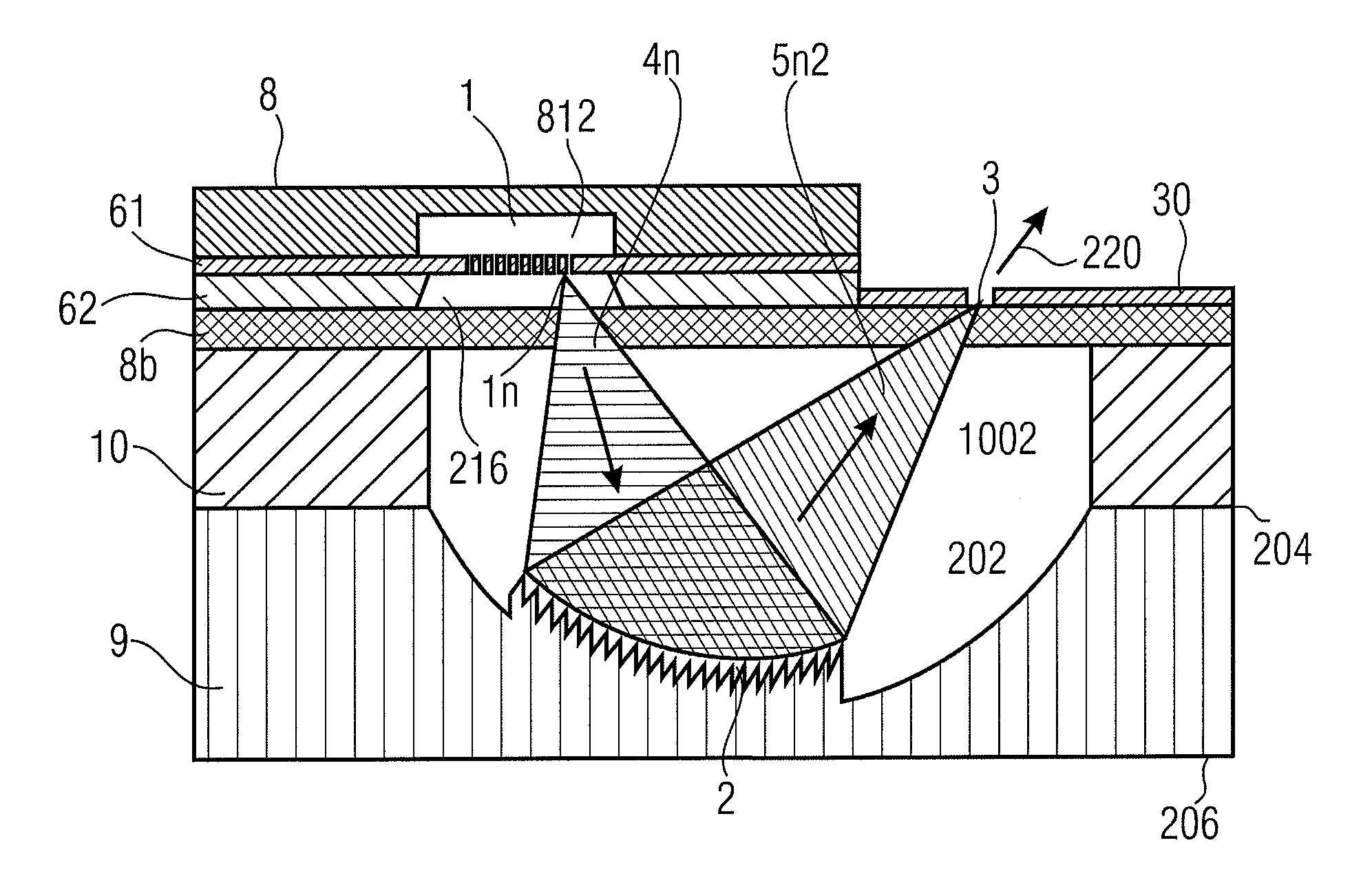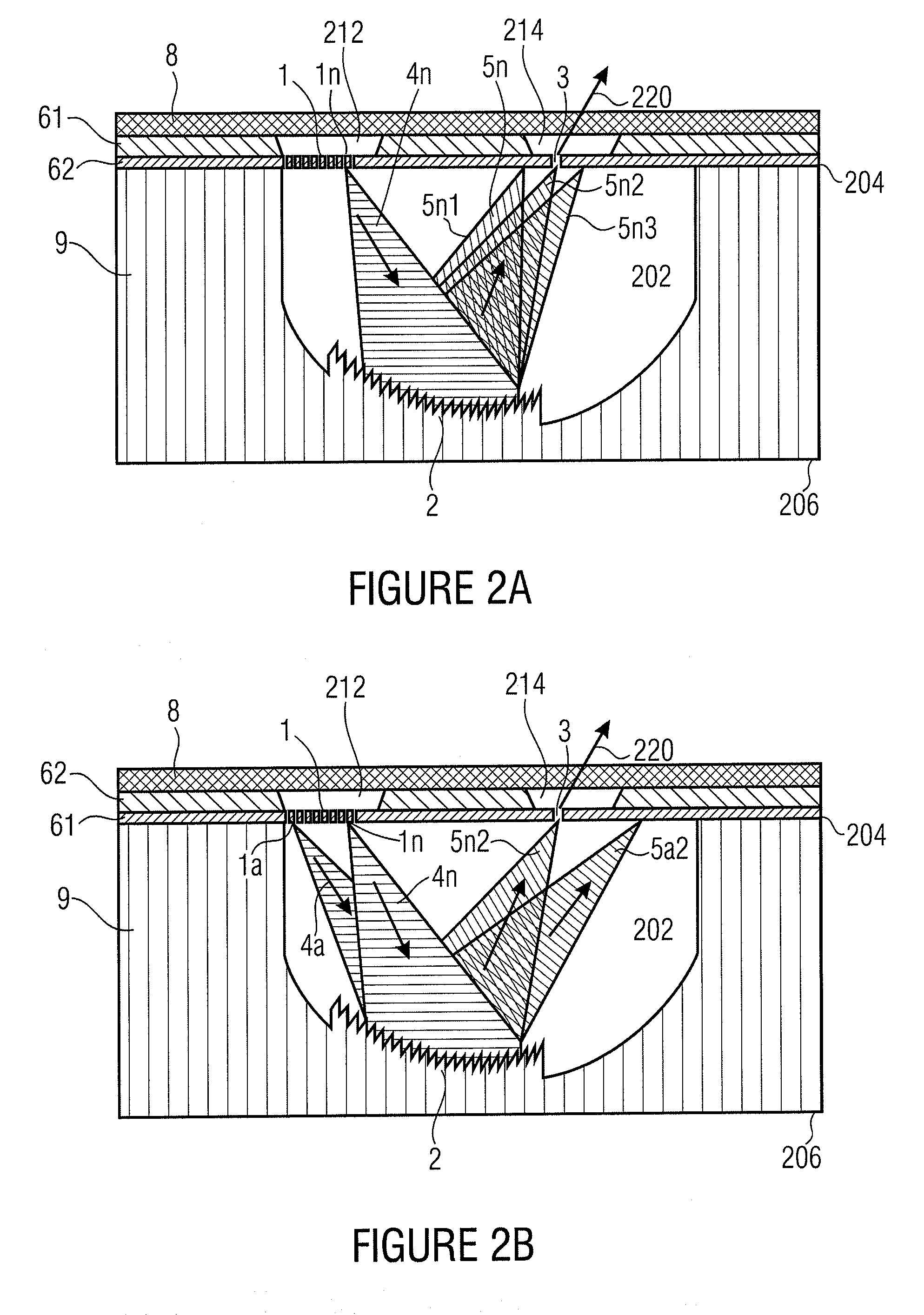Radiation Generation Device for Generating Electromagnetic Radiation Having an Adjustable Spectral Composition, and Method of Producing Same
a radiation generation device and electromagnetic radiation technology, applied in the field of radiation generation devices for generating electromagnetic radiation having an adjustable spectral composition, can solve the problems of increasing overhead for the overall system, affecting the miniaturization of the overall system, and requiring a large amount of effort for the use of several detectors
- Summary
- Abstract
- Description
- Claims
- Application Information
AI Technical Summary
Benefits of technology
Problems solved by technology
Method used
Image
Examples
first embodiment
[0047]FIG. 2a shows a schematic cross section of a radiation generation device comprising a first carrier substrate 62, a diaphragm layer or functional layer 61, a second carrier substrate 9, and an encapsulation substrate 8. The second carrier substrate 9 has a first surface 206 and a surface 204 opposite said first surface. The second carrier substrate 9 further has a one-sided recess or cavity 202 that is upwardly opened, in the orientation of FIG. 2a, i.e. that comprises an opening on the side of the second surface 204. The first surface 206 has the functional layer 61 arranged thereon, wherein the radiation elements 1, e.g. the radiation elements 1a to 1n of FIG. 1a, as well as the optical opening 3 are formed. The radiation elements are laterally separated by continuous recesses extending from a first surface of the functional layer, which faces the second carrier substrate 9, to a second surface, opposite the first one, of the functional layer 61, and the optical recess is fo...
second embodiment
[0066]FIG. 3 shows the radiation generation device, wherein the radiation elements 1 are configured as filaments 1 which, in turn, are arranged in or on an SOI substrate 61, 62. In the embodiment depicted in FIG. 3, the SOI substrate, more specifically the functional layer 62, is encapsulated, on its front side, with a further substrate 8, which is also referred to as an encapsulation substrate 8 and may be a glass substrate, for example. The dispersive optical element 2 used is, again, a concave diffraction grating 2, which is integrated, on the reverse side, into a corresponding second carrier substrate 9. The second carrier substrate 9 may be directly used for front-side encapsulation of the SOI substrate 61, 62. The second carrier substrate 9 is manufactured from a material transparent to electromagnetic radiation, for example from glass or plastic, and, at the same time it serves as the carrier substrate for the opening 3 for coupling out the resulting electromagnetic radiation...
fourth embodiment
[0073]In other words, FIG. 5 generally shows a schematic cross section of a radiation generation device comprising a first carrier substrate 63, radiation elements 1, a second carrier substrate 9, an encapsulation substrate 8, and a non-transparent layer 30. The second carrier substrate 9 has a first surface 206 and a surface 204 opposite said first surface. The first surface 206 of the second carrier substrate has the encapsulation substrate 8 arranged thereon, which comprises a recess 814 arranged below the radiation elements 1.
[0074]The first carrier substrate 63 is arranged above the encapsulation substrate 8, i.e. on the second surface of the encapsulation substrate 8. The radiation elements are arranged on the bottom side of the first carrier substrate 63, i.e. on the first surface of the first carrier substrate 63, which faces the encapsulation substrate 8. The recess 814 of the encapsulation substrate 8 is arranged below the radiation elements and comprises an opening in the...
PUM
| Property | Measurement | Unit |
|---|---|---|
| length | aaaaa | aaaaa |
| length | aaaaa | aaaaa |
| length | aaaaa | aaaaa |
Abstract
Description
Claims
Application Information
 Login to View More
Login to View More - R&D
- Intellectual Property
- Life Sciences
- Materials
- Tech Scout
- Unparalleled Data Quality
- Higher Quality Content
- 60% Fewer Hallucinations
Browse by: Latest US Patents, China's latest patents, Technical Efficacy Thesaurus, Application Domain, Technology Topic, Popular Technical Reports.
© 2025 PatSnap. All rights reserved.Legal|Privacy policy|Modern Slavery Act Transparency Statement|Sitemap|About US| Contact US: help@patsnap.com



